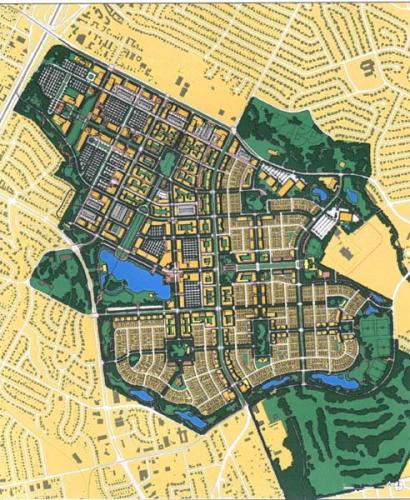
Robert Mueller Municipal Airport Reuse Plan
Location: Austin, Texas, United States. Former Airport
Robert Mueller Municipal Airport Reuse Plan, Austin, Texas
The Robert Mueller Municipal Airport Reuse Plan calls for redevelopment of a major metropolitan passenger airport, and provides an infill antidote to suburban sprawl. The 711-acre city-owned site will be transformed into a mixed-use district that exemplifies a community’s goals for smart growth and sustainable development. The site is surrounded by single-family neighborhoods which had long been impacted by airport operations, and a main goal of this plan is to demonstrate an alternative to the low intensity sprawl occurring in many parts of the region.
“This is a great example of a new neighborhood that is integrated into its surroundings. The new area will share open space and boulevards with adjacent suburban developments,” says Charter Awards juror Harvey Gantt.
The approved plan calls for the creation of a community that will include a range of housing opportunities including 4 million square feet of office development, 350,000 square feet of retail uses, an elementary school, churches, and community centers. The community is structured as an interconnected grouping of compact and walkable neighborhoods and districts surrounding a higher-density mixed-use Town Center. The most intensive uses are concentrated in the Town Center and around a central transit station. This retail center is also accessible from the adjacent arterial roadway, so that it can serve a broader segment of the city.
The site will be developed with a multitude of uses in all areas with an emphasis on creating a balance between jobs and housing. The neighborhoods will include a complete range of housing types, and the City is also committed to ensuring that 25% of all homes are offered as affordable.
Appropriate building types made of regional materials have been prescribed within each of the neighborhoods. The plan stipulates build-to lines, setbacks and orientation criteria for particular street types and public spaces. Town Center streets will require mixed-use buildings that reinforce an active street frontage. Higher-density buildings with ground level retail are required adjacent to transit stops along the light rail corridor that will eventually form the central spine of the community.
The original topography of the site will be restored to the greatest extent possible. Landscaped open spaces make up 20% of the new property and are linked to existing neighborhoods. These spaces include a central park and lake, a town park, perimeter greenways featuring a network of bike trails, community playfields, neighborhood parks and pocket parks. This greenway will provide important drainage and stormwater retention facilities for the site, featuring a series of ponds that will filter urban runoff before it enters the creek system. A 1930s historic hangar will be preserved in place as a major community center and will overlook a large lake. The lake will serve as a major identity feature and recreational amenity.
This project is intended to be a catalyst for economic renewal throughout the area. Like many cities, Austin has been socially, economically and racially divided by a major transportation corridor: the Interstate freeway. This corridor has long served as a barrier to investment, and contributes to deterioration of much of the eastern part of the city. The redevelopment of a significant property within this area offers an opportunity to change this perception and encourage new investment in existing neighborhoods. As such, a key focus of the project is to create a community that will enhance the quality of life and the identity of the area, to make it more attractive for investment and revitalization.
Project: Robert Mueller Municipal Airport Reuse Plan, Austin, Texas
Site: 711 acres, former metropolitan passenger airport. The site is City-owned, and surrounded by single-family neighborhoods.
Program: A compact pedestrian and transit-oriented community with mixed uses. The community will be easily accessible from surrounding existing communities, and will enhance the work and retail opportunities in the area.
Architect/ Planner/ Landscape Architect: ROMA Design Group
Public Agency: Austin Planning, Environmental & Conservation Services
Owner/ Developer: City of Austin
Engineers: Earth Tech
Consultants: Jose E. Martinez & Associates
Consultants: Economic & Planning Systems
General Contractor: Corcoran Jennison Construction Company
Transect Zone(s): T1 preserve.
Status: <Unknown>
Project or Plan's Scale: Town
Land area (in acres): 711
Total built area (in sq. ft.):
Total project cost (in local currency):
Retail area (in sq. ft.):
Office area (in sq. ft.):
Industrial area (in sq. ft.):
Number of hotel units:
Number of residential units (include live/work):
Parks & green space (in acres):
Project team designers: ROMA Design Group
Project team developers: City of Austin
Previous site status:
Starting/Ending date of construction/implementation: -


